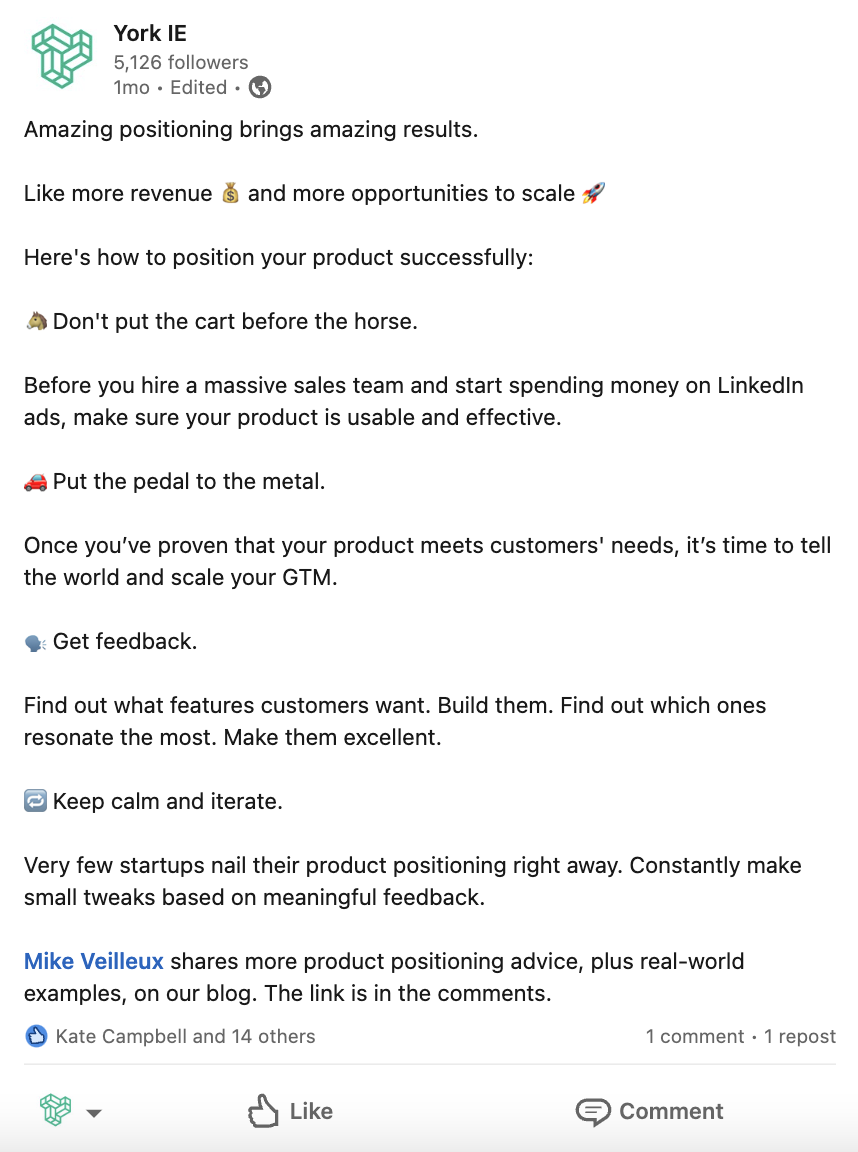Repurposing content is a great way to maximize the value you get out of the ebooks, blog posts, webinars and podcasts you create.
Creating a marketing plan lays the foundation for your growth, but consistently producing content and telling your story is how you actually build your brand. By repurposing, you can do this more efficiently and effectively than if you were creating every piece of content individually.
What is Content Repurposing?
Content repurposing, also known as content recycling or content reusing, is a marketing strategy that emphasizes presenting existing content in new formats and distributing it through multiple channels. Repurposing content enables creators to maximize the value of their work and reach new audiences.
In this guide, we’ll cover the benefits of repurposing content, how to do it and which content types are the best candidates. We’ll also share some real-world examples. But first, here’s a story that illustrates the power of repurposing:
In 2021, my first year at York IE, we published more than 150 blog posts. It takes a lot of work to come up with that many content ideas and make them a reality. Our strategy was basically, “identify keywords that align with our core messaging and try to rank for as many of them as possible.” We were creating every post in a vacuum — in addition to handling the one-off posts that other employees were creating, writing press releases, etc. It just wasn’t sustainable.
When you produce so much content, it’s hard to give any one piece all the attention it deserves — from creation and optimization to promotion and distribution — because you have to move on to the next piece.
The next year, we approached things differently. We focused on creating two types of pillar content: monthly webinars and templates. Then we took those and repurposed them into additional content (blog posts, native LinkedIn posts, YouTube and social videos, etc.).
We ended up publishing 35 fewer blog posts for the year — about a 25% decrease. But our annual traffic actually increased by 45%, and our organic traffic more than doubled.
Benefits of Repurposing Content
The benefits of repurposing content include:
- greater credibility;
- broader appeal;
- efficient, organized content creation; and
- better ROI.
Greater Credibility
It’s so hard to keep your messaging aligned when you’re creating a bunch of standalone pieces of content. But if you take long-form content, such as a video presentation or podcast, and you slice and dice it into smaller pieces, such as blog posts and Twitter threads, they will all have consistent messaging because they all flow from the same source.
When you deliver a consistent point of view to your audience in new ways over and over again, you begin to become known for that point of view in your market — the ultimate goal of our drumbeat marketing philosophy.
Broader Appeal
I’m a big social media person. I don’t read a lot of newsletters, but I love scrolling through LinkedIn looking for new ideas and advice. Lots of people love newsletters, though. Some prefer blogs. Others immerse themselves in podcasts and videos.
If you only publish blog posts, you’re limiting your audience to people who like to read blogs. By repurposing content, you can make your messaging more accessible to a larger audience.
Efficient, Organized Content Creation
Content marketing involves a lot of moving pieces. No matter how organized you are, there are things out of your control. Writers miss deadlines. Subject matter expert interviews fall through. Approval emails go unanswered.
And the more individual pieces of content you plan, the more these issues compound, throwing your calendar into disarray.
When you plan one large piece of content with repurposing in mind from the start, you can eliminate a lot of these problems. There’s more upfront work that goes into producing an hourlong webinar or a 5,000-word ebook, but once the event is over or the ebook is published, you have everything you need to start creating more content.
For example, last year we turned one webinar into two YouTube videos, two social video clips, two blog posts and six LinkedIn posts. It was July, and I was scheduling complete, approved, high-quality content to be published in November.
Better ROI
Repurposing content is more efficient. It ensures every piece gets the promotion it deserves, because distribution is baked into the process. If you can create less content and get more traffic, why wouldn’t you?
Which Content Should I Repurpose?
You can repurpose any type of content. Break up large pieces and turn them into a series of smaller posts. Or take a bunch of smaller pieces and turn them into a big, premium product.
Here are some of my favorite types of content to repurpose:
Large Written Pieces
Ebooks, white papers and other longform content are great candidates for repurposing. A 5,000 word ebook can easily become five or 10 blog posts. And longform content is usually organized into distinct sections or chapters, which means it’s easy to decide how to break it up.
From there, add the necessary context to each section so it can stand on its own, include links between the new pieces, and you’re good to go.
Longform Multimedia
Webinars and podcasts can yield multiple smaller pieces of multimedia and written content. The key is to plan for repurposing in advance so you’re not poring over transcripts, trying to figure out how to reuse what was said.
Internal Communications
Look inside your company’s own walls. Internal communications and other business documents can be a great jumping-off point (or at least serve as inspiration) for external marketing content.
In the past, we’ve turned a due diligence questionnaire response into a blog post and turned part of an investor update into a LinkedIn post. We’ve even taken transcripts of team strategy calls and used them to create thought leadership content.
It goes without saying that you can’t just take these documents, cut and paste them into your content management system and publish them. They often contain confidential or sensitive material that you can’t share with the world, and they probably need additional context for external audiences.
But they usually contain broader insights that you can share with your audience. Take advantage of this opportunity.
Old, Successful Content
Do you have a tweet or LinkedIn post that performed well this month? It will probably perform well next month, too.
You don’t want to say the exact same thing in the exact same format, but small tweaks and changes in presentation can keep your content feeling fresh while hammering home the same overall point.
And don’t worry that you’ll turn off your audience by repeating yourself. Repetition is the only way to break through the noise and become known for something.
How to Repurpose Content
Here are some of the best ways to repurpose content:
- Turn ebooks and white papers into multiple blog posts.
- Use blog sections as LinkedIn posts and Twitter threads.
- Break webinars and podcasts up into YouTube videos.
- Cut YouTube sound bites into social videos.
- Write blogs based on audio transcripts.
- Create social graphics from charts.
- Package up related blogs as guides.
There are numerous ways you can do it, depending on the type of content. For an example, here’s how we go about repurposing content from our webinars, and how you can turn your webinars into a content engine too:
1. Plan in Advance
Come up with questions that align with your content goals (targeting specific keyword phrases, building thought leadership, etc.).
2. Turn One Large Video into Multiple Smaller Videos
Cut the videos of each answer and put them on YouTube. Use the question as the title if it’s something people ask or search for a lot.
3. Turn the Videos into Blog Posts
Clean up and optimize the transcripts of each answer and publish them on your blog. Embed the related YouTube video in each post.
4. Create Social Assets
Cut the best sound bites into 30- to 60-second social video clips. Put the best quotes on graphics with the speaker’s headshot.
5. Turn the Blogs into Social Posts
Break each blog post up into smaller LinkedIn posts or Twitter threads. Publish them alongside the social videos and graphics. Link back to the blog.
Content Repurposing Examples
York IE CTO Mike Veilleux gave a webinar last year on the path to product market fit. Following the steps above, we created two YouTube videos:
What Is Minimum Viable Product (MVP) and Audience (MVA)?
How to Position Your Startup’s Product
We then turned each video into a blog post:
And we created multiple LinkedIn posts, such as this one:

Always Be Repurposing
Repurposing content doesn’t have to be a huge process.
It’s not always about planning an e-book or a podcast or a webinar and how you’re going to break that down into blog posts and then how you’re going to break those blog posts into LinkedIn posts and Twitter threads.
Don’t get me wrong: That’s very valuable. But it takes a lot of work.
Sometimes, though, content repurposing is as simple as identifying content created for one purpose and using it for another.
For example, last year Matt Shapiro, York IE director of investments, interviewed all the founders in our most recent investment cohort over Zoom. His initial idea was to include the videos in the update packet that we share with our investors.
But we could see the videos had more value, for a wider audience. So we posted them on YouTube:
And then we realized that the founders’ answers to the question “Why did you choose to work with York IE?” provided some amazing social proof. So we clipped those, added titles and captions and rolled them out on social media:
What makes or breaks a startup? It’s the people!
That’s why we’re so excited to invest in @pieropoli and the entire Evorra team. pic.twitter.com/uJEig6WlvU
— York IE (@yorkgrowth) August 17, 2022
Always keep your eyes peeled for new ways to use existing content. Once you know how to repurpose content, you’ll see opportunities everywhere.



